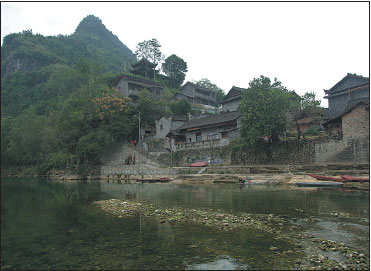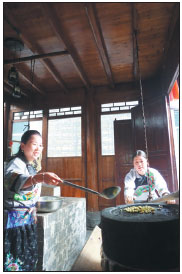Memories of protected Miao village inspire travelers
As I arrived at Pinglang village, a sweet smell of flowers surrounded me and I could not help taking a deep breath to enjoy nature's gift.
Walking onward, I saw a clear and wide river, across which were the well-arranged houses of the Miao ethnic group on the foot of the mountain. The river separates the residences from the outer highway, creating a tranquil environment for them.
A mother was washing clothes beside the river while her children were playing on the riverbank. They and the surrounding beautiful scenery were in the view of a grandmother who sat idly in front of her door.
The village is in the west of Aizhai town and 14 kilometers away from downtown Jishou, the capital of Xiangxi Tujia and Miao autonomous prefecture in Hunan province.
A local friend told me there was a road that starts from the outskirts of Jishou and passes through the village. Cycling enthusiasts usually ride along the mountain-flanked road on weekends, enjoying their leisure time.
In an alley in the village, I saw a tofu workshop that the Shi family has run for more than 100 years. Shi Qingxiang, who owns the shop, was turning a stone mill with a wooden tool to grind the soybeans.
Visitors to the shop have the chance to push the mill and taste fresh bean curd jelly, as well as soybean milk. The jelly tasted more tender than any I had had in other shops; Shi said that was because she used the stone mill instead of a machine.
The water she uses to soak soybeans is from the nearby mountain spring and local villagers plant the soybeans. Shi said she wants to use these resources well and continues to make tofu manually, a technique she inherited from her father.
The Pinglang tofu manufacturing technique became an item of ethnic and folk traditional culture protection in Jishou in 2013.
This is the attraction of the village, I think, that it has both an excellent natural environment and well-preserved culture.
Most of the Pinglang villagers can play local Miao drums, which is also called drum dancing. They perform at important festivals and sometimes to welcome visitors to the village.
A center for protecting and learning Xiangxi Miao drum dancing was built in the village in May 2015. Shi Jinqi, a local villager and an inheritor of the Xiangxi Miao drum dancing, said she has taught children left behind by their migrant-worker parents, old people and others who wanted to learn drum dancing at the center.
She said an important task of Pinglang, a pilot village for cultural and ecological protection in Xiangxi, is to help the Miao drum dancing pass on to the next generations.
The village, which is home to nearly 1,500 people, also set up a Miao embroidery center in May 2013, to help promote and protect the intangible cultural heritage.
The trip in beautiful Pinglang has left a lasting memory in my mind and I am hoping to visit again with family and friends.
|
Pinglang village, with its traditional Miao ethnic group houses.Xiang Wenjun / For China Daily |
|
Shi Qingxiang (left) showcases the Pinglang tofu manufacturing technique with her sister in Pinglang village.Li Li / China Daily |
(China Daily 10/18/2016 page6)




















